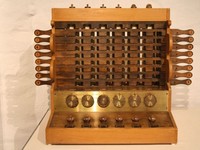Wilhelm Schickard invents a calculating machine
|
1623 In 1623, Wilhelm Schickard invented a calculating machine, called by his contemporaries the Speeding Clock or Calculating Clock. It preceded the less versatile Pascaline of Pascal and Leibniz's Stepped Reckoner by twenty years. Schickard's letters to Johannes Kepler show how to use the machine for calculating astronomical tables. The machine could add and subtract six-digit numbers, and indicated an overflow of this capacity by ringing a bell. To add more complex calculations, a set of Napier's bones were mounted on the machine. Schickard's letters mention that the original machine was destroyed in a fire while still incomplete. The designs were lost until the 19th century; a working replica was finally constructed in 1960. Schickard's machine was not programmable. The first design for a programmable computer came roughly 200 years later, invented by Charles Babbage. The Institute for Computer Science at the University of Tübingen is called the Wilhelm-Schickard-Institut für Informatik in his honor. Related information: Image:
|
Click on the Images For Detail
|










